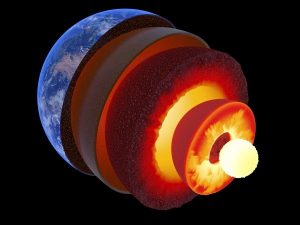
“It’s a very provocative paper … a bit speculative,” says Thomas Duffy, a geoscientist at Princeton University who was not involved with the study. “But it’s taking us in an important step on the road to understanding the deep Earth.”
Most volcanoes form because tectonic plates, vast sections of Earth’s crust, smash against or slide underneath each other. The pushing and melting there feed the volcanoes in the infamous Ring of Fire around the Pacific Ocean. But hot spot–spawned volcanoes like Hawaii’s are a different breed. They are nowhere near tectonic plate edges, and yet millions of years ago they spewed out so much lava that they nearly blanketed whole continents with molten rock or covered the globe with soot. Geologists believe the source of this magma is coming from just above Earth’s outer core, but they’re not exactly sure how.
Alexander Goncharov, a geophysicist at the Carnegie Institution for Science in Washington, D.C., and colleagues think that there are patches of magma—remnants from an early molten stage of our planet’s history—quilted around the outer core. Because the bottom of Earth’s mantle is nearly 3000 kilometers below the surface—about a 3-day journey if you could drive there by car—temperatures and pressures reach such hellish extremes that the atomic structures of these magmas are different from those they would have at lesser pressures. Duffy says that “can really change physical properties a lot,” including the way the material looks and absorbs heat.
To test how magma might behave near the core, Goncharov and his colleagues squeezed a sliver of a dark, opaque glass, made from iron and silicate to mimic the composition of deep Earth magmas, between two diamonds to simulate pressures near the core. The team then shined an infrared light through the glass and measured how much light passed through. As the pressure increased, so did the amount of light the glass absorbed, and the team saw a change in the atomic structure of the glass, the researchers report online today in Nature Communications.
Goncharov says that means magmas at high pressures in the lower mantle must be sponging up heat emanating from the core. As these patches of magma around the core get hotter, they start to act as a door for heat to pass into the mantle by convection. The heated mantle rocks then move up through the planet in a massive plume until they erupt on the surface, creating large volcanoes in strange places like Hawaii, Yellowstone, Easter Island, and Mount Etna, and some of the most violent eruptions.
If the team is right, its work could illuminate a key part of Earth’s geology. Duffy says these plumes are “one of the most important things to understand,” because the movement of heat powers many processes on the planet. For one, Earth’s magnetic field depends on how the core spins and flows inside the planet. As a result, Duffy says, “the way heat flows from the core to the mantle could potentially affect the way Earth’s magnetic field evolves over time.”
Not everybody is ready to get behind Goncharov and his colleagues’ new hypothesis. “There are two fundamental limitations of the paper,” Duffy says. “First that they’re studying a glass and not [melted rock], and there’s the fact that [the experiment] is at room temperature and not high temperature.” Until scientists perform the experiment with molten rock heated to about 3200°C, Duffy says, they can’t be sure how the magma really behaves.
And geologists still contest whether the pockets of magma around Earth’s outer core actually exist. To probe Earth’s interior, scientists rely on seismic waves from large earthquakes that have to travel through 3000 kilometers of rock. At that depth, the measurements become “a little bit ambiguous,” Duffy says. “And there’s a question as to why the liquid wouldn’t just all drain [away].” Because these dark magma pockets float above the core, it’s a bit like imagining an ocean rising tens of kilometers above sea level. “It’s not impossible,” he says, “but the idea that there’s melt in the deep
mantle is controversial.”
Reference:
Motohiko Murakami,Alexander F. Goncharov,Naohisa Hirao,Ryo Masuda,Takaya Mitsui,Sylvia-Monique Thomas& Craig R. Bina , http://dx.doi.org/10.1038/NCOMMS6428
Note: The above story is based on materials provided by American Association for the Advancement of Science. The original article was written by Angus Chen.










